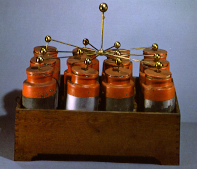
60.8 x 52 x 68.3
Glass, tin leaf, brass and wood
CAT. 1878 : 406
Bateria electrica de doze garrafas grandes (Salleron).
Electric battery comprising twelve large jars (Salleron).
After the discovery of the condensing "electric fluid" effect shown by the Leyden jars, Bevis and Watson had the idea of joining several jars together. A metal chain maintained contact between the external shielding of the jars and the ground. The internal shields were also in contact with one another by means of metal rods, so that all the jars were electrically charged simultaneously when connected to the electrostatic appliance. This assembly was called an electrostatic battery. In these conditions the amounts of "electric fluid" received by the different jars would be equal, if they were geometrically identical.
The cascade model was perfected by Franklin who used electric batteries like the one described above. The batteries were themselves linked in sequence, with the common connection point of the internal shields of one battery being joined to the common connection point of the external shields of the next battery.
The electric battery on display was acquired by the Gabinete de Física in 1864 and consists of an array of twelve Leyden jars arranged in a wooden box with twelve compartments. Each compartment communicates with its neighbour by means of a piece of tin leaf placed in the dividing wall, thereby permitting electrical contact between the outer shields of the jars. Contact between the internal shields is established by means of brass rods whose ends penetrate the terminal spheres of the shafts and make electrical contact with the internal shields of each jar.
The amount of "electric fluid" stored in each jar was evaluated by means of an electrometer connected to the sphere of one of the jars.
Sigaud de la Fond, Joseph-Aignan, Description et Usage d'un Cabinete de Physique Expérimentale, 1775, Vol. II, Pl. XXII.